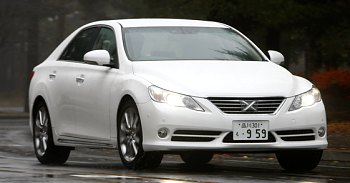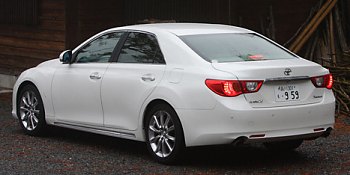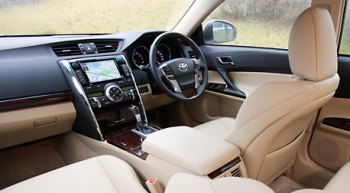|
|
Toyota Mark X
Debut: 2009
Maker: Toyota
Predecessor: Mark X (2005) |
|

|
The son of Mark II is facing a
possibility of extinction...
|
An
anonymous car ran nearby. Initially it appeared to be a Lexus IS, but
once you had adjusted your focus, you would find it a little larger and
more organic. Wing-shape headlamps, curvy front fenders and sporty
skirts attempt to deliver a "driver's car" impression. More exciting,
its long-hood proportion implied longitudinal engine and rear-wheel
drive. Its grille was dominated by a cross – what brand is it ?
In fact, it is the letter "X", standing for Mark X. English automotive
world has long ignored Toyota Mark X because its sales has always been
bounded in the domestic market. Back in Japan, Mark X and its
predecessor Mark II enjoyed quite
some reputation as a driver-oriented
executive car, or an affordable alternative to the imported BMWs. In
its hey days, Mark II (and Nissan Skyline) fended off the foreign
competition very well.
 |
Sales target of 36,000 cars a year is
merely enough to recover its development cost...
|
However, those
days have gone. Today, globalization is deemed to be a must for
survival. Continuous shrinkage of the domestic market and the shift to
K-cars make the home-bounded Mark X and Skyline all the more difficult
to survive. This is why Nissan redesigned Skyline to be a global car
(Infiniti G-series). But the bureaucracy inside Toyota is more
resisting to drastic changes. Despite of the overlapping with Crown
Athlete and Lexus, it still gave Mark X a new generation in 2009. Sales
target has been lowered from 60,000 to 36,000 cars a year, a figure
merely enough to recover its development cost. Target customers are
manager-grade males at their 50s. Its survival space is narrow,
especially compared with the ever-extending range of Crown.
The second generation Mark X - shall we call it Mk X Mk II ? - is not
an all-new redesign. In my opinion, it is old wine in a new bottle. The
old wine is the FR platform which it shares with the old car as well as
Crown. Its 2850 mm wheelbase, double-wishbone front and multi-link rear
suspensions are carried over. The same goes for the adaptive air
suspensions at the top model. The only mentionable upgrade is VGRS
variable gear ratio steering, yet it is only available on higher-spec.
models. Mechanically, the new Mark X is so close to the old car that
its overall length, height and wheelbase are identical. Only its width
is increased by 20 mm.

|
The new bottle is definitely more
modern...
|
The new bottle
is definitely more modern than before, especially inside, where quality
plastics and switch gears are finally presented. Nevertheless, the
interior is short of style as well as fancy features. If you are
looking for a TFT LCD instrument reading like Crown, you will be
disappointed to find out its traditional gauges. Ergonomic-wise, its
center console is hard to fault. It just lacks some sense of occasion
to satisfy our ever increasing pursuit for luxury.
Thanks to the long wheelbase, there is plenty of knee room for rear
passengers. The increased width enabled the front seats to position 20
mm further apart, liberating elbow room. However, to make the Mark X
cheaper as well as lighter (by about 100 kg) than Crown, it sacrifices
some sound insulation and standard equipment. A base Mark X is leanly
equipped with fabric seats with manual adjustment and the simplest CD
player / radio - not even Bluetooth is offered ! Fully equipped with
high-spec audio, sat-nav, pre-crash safety system, radar cruise
control, 8-way electric leather seats, air suspensions, VGRS and
a powerful 3.5-liter V6, the Mark X becomes really expensive. Therefore
the majority of sales goes to the base 250G model.
 |
Time did not improve the 2.5 engine,
but actually worsened it...
|
250G, as
indicated by its name, is powered by a 2.5-liter V6. The
direct-injection engine is basically the same unit as in the last
generation, but its output has been detuned to 203 horsepower, versus
the previous 215 hp, in order to enjoy environmental car tax benefit.
In normal
driving, it serves well as an executive car powertrain together with
the smooth-shifting 6-speed automatic gearbox. However, if your right
foot ask more from it, you will be frustrated by its lack of low-down
torque as well as its coarse vocal from 4000 rpm upward. It feels
noticeably slower than the old car. Now 0-60 mph takes 8 seconds,
disappointing for a driver-oriented machine. Apparently, Toyota's
4GR-FSE engine is no match with BMW's 2.5-liter straight six for both
performance and refinement. Time did not improve it, but actually
worsened it.
The 250G's 215/60R16 rubbers result in a supple and quiet ride.
Undoubtedly, there is some playfulness in its FR chassis. Its rear axle
feels more lively, and the front end is more eager than Toyota's
front-drive models. A pity the modest setup in 250G does not put this
chassis in good use.
 |
Quick and capable but not very much
fun, 350G drives very much like Lexus IS350...
|
Naturally,
350G is much better. Its air suspensions might be less refined on
high-frequency bumps, but it tightens the body roll. The 235/45WR18
rubbers generate much more grip to encourage attack mode. The VGRS
steering is also more responsive than the standard setup, although it
is still short of communication. The 3.5-liter V6 comes straight from
Lexus and Crown, using its dual-injection (port injection plus direct
injection) and extra capacity to produce a respectable 318 horsepower,
i.e. 62hp more than the 3.0-liter engine of the old Mark X. Though
performance figures are not revealed, I think it should be capable of
doing 0-60 in 5.5 seconds. That said, compare with the best
six-cylinder engines like that of BMW 335i or Infiniti G37, the
2GR-FSE's power band is rather narrow. It needs to be revved harder to
get the best. Besides, its sound is also quite dull. Overall, Mark X
350G drives very much like Lexus IS350. It is quite quick and capable,
but it does not deliver the communication and excitement of its German
rivals.
Nevertheless, the greatest threat of Mark X does not come from the
German, but from the internal competition of Crown. In recent years, we
saw Crown received much greater care from its creator. It got the
latest technology like hybrid powertrain as well as an ever more
sporting Athlete model. Moreover, it continues to be the best selling
executive car in Japan. All these mean Mark X becomes rather
superfluous. If it does not sell better, this generation might just be
the last of its line.
|
| The
above report was last updated on 13 Feb 2010. All Rights Reserved. |
| Specifications
|
|
|
|
|
Table 1
|
11
|
12
|
13
|
| General remarks |
| Layout |
| Chassis |
| Body |
| Length / width / height |
| Wheelbase |
| Engine |
| Capacity |
| Valve gears |
| Induction |
| Other engine features |
Max power
|
Max torque
|
| Transmission |
Suspension layout
|
| Suspension features |
| Tires |
| Kerb weight |
| Top speed |
| 0-60 mph (sec) |
| 0-100 mph (sec) |
|
| Mark X 250G |
Front-engined, RWD
|
| Steel monocoque |
| Mainly steel |
| 4730 / 1795 / 1435 mm |
| 2850 mm |
V6, 60-degree
|
| 2499 cc |
DOHC 24 valves, DVVT
|
| - |
| DI |
203 hp
|
179 lbft
|
| 6-speed automatic |
F: double-wishbone
R: multi-link
|
| - |
| 215/60HR16 |
| 1530 kg |
| - |
7.9 (c)
|
| - |
|
| Mark X 350S |
Front-engined, RWD
|
| Steel monocoque |
| Mainly steel |
| 4730 / 1795 / 1435 mm |
| 2850 mm |
V6, 60-degree
|
| 3456 cc |
DOHC 24 valves, DVVT
|
| - |
| DI |
318 hp
|
280 lbft
|
| 6-speed automatic |
F: double-wishbone
R: multi-link
|
Adaptive air springs
|
| 235/45WR18 |
| 1560 kg |
| - |
5.5 (est)
|
| - |
|
|
|
| Performance
tested by: - |
Copyright©
1997-2010
by Mark Wan @ AutoZine
|
|
|




